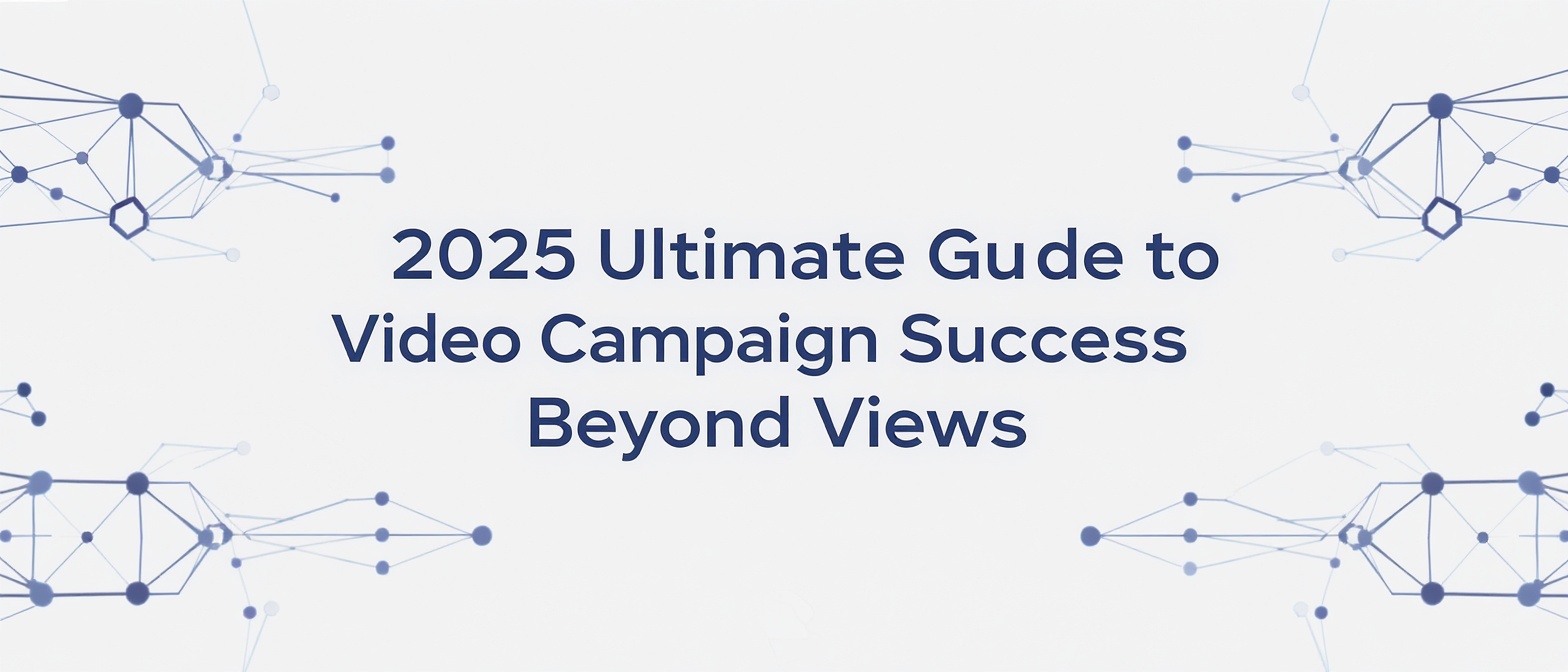Beyond Views: The Ultimate Guide to Measuring Video Campaign Success in 2025
Estimated Reading Time: ~10 minutes
Key Takeaways
- Shift from vanity metrics to a full-funnel approach for deeper insights
- Engagement metrics are critical for evaluating content quality
- Use advanced analytics & AI to measure ROI across all stages
- A/B testing and multi-touch attribution improve conversion outcomes
In the digital landscape of 2025, video isn't just a part of the internet; it's rapidly becoming the internet itself. With video content projected to account for a staggering 82% of all internet traffic, its dominance is undeniable. Brands are investing more than ever, with 89% of businesses now using video as a core marketing tool. Yet, for all this investment, a critical question often gets a fuzzy answer: "Is it actually working?" Measuring your video campaign success is the crucial, non-negotiable step that separates wasteful spending from profitable, scalable strategy.
For too long, marketers have clung to the comfort of vanity metrics. A high view count feels good, but it doesn't pay the bills. True success lies deeper, in understanding how video influences audience behavior, builds brand equity, and directly contributes to the bottom line. This guide moves beyond the superficial to provide a comprehensive, multi-layered framework for video performance analysis. We'll explore the full funnel of metrics—from initial awareness to final conversion—and uncover how advanced analytics and AI are revolutionizing our ability to prove and improve video ROI in 2025 and beyond.
The Evolution of Video Metrics: Moving Past Vanity in 2025
The game has changed. With consumers estimated to spend an average of 100 minutes per day watching online videos by 2025, their attention has become the new currency. A "view" is no longer a reliable indicator of success. A three-second auto-play view on a social feed is fundamentally different from a viewer who watches an entire two-minute product demo.
The modern approach to video analytics requires a shift in mindset from "views" to "value." This means categorizing your metrics to align with specific stages of the customer journey. A successful measurement framework doesn't treat all data points as equal; it weighs them according to the campaign's objectives.
We can organize this framework into three distinct levels:
- Awareness Metrics: Did your target audience see your video? These top-of-funnel metrics gauge reach and visibility.
- Engagement Metrics: Did your video capture and hold audience attention? These middle-funnel metrics measure interest and interaction.
- Conversion Metrics: Did your video inspire action? These bottom-of-funnel metrics are the gold standard, directly linking video to business results.
Understanding which metrics to prioritize at each level is the first step toward building a truly data-driven video strategy.
Level 1: Foundational Awareness Metrics (The Top of the Funnel)
Awareness is the first step in any marketing funnel. The goal here is to get your video in front of as many relevant eyeballs as possible. While these metrics are the most basic, they provide a crucial baseline for campaign reach.
-
Views & Reach:
- Views: The total number of times your video has been played. It's important to understand how each platform defines a "view" (e.g., 3 seconds on Facebook vs. 30 seconds on YouTube).
- Reach/Unique Views: The number of individual people who saw your video. This is often a more valuable metric than total views, as it indicates the actual size of your audience.
- Limitation: A high view count with low engagement can indicate that your video appeared in many feeds but failed to capture interest.
-
Impressions:
This is the number of times your video was displayed on a screen, whether it was played or not. A high number of impressions but a low view count points to a problem with your video's thumbnail, title, or initial hook. It's a critical diagnostic tool for understanding why people aren't even starting to watch.
-
Brand Recall & Awareness Lift:
This is a more sophisticated awareness metric, often measured through surveys and platform-specific tools (like Google's Brand Lift). It answers the question: "Are people more likely to remember our brand after seeing our video?" Tracking this provides concrete evidence that your video is successfully building brand equity, a key long-term goal for content marketing. Authoritative studies from Think with Google have consistently shown the power of video in boosting brand recall.
Level 2: Critical Engagement Metrics (The Heart of the Matter)
This is where the real story of your video's performance unfolds. Engagement metrics tell you not just if people saw your video, but if they cared. They are the strongest indicators of content quality, relevance, and audience connection.
-
Watch Time & Average View Duration (AVD):
Arguably the most important engagement metric. Watch Time is the total amount of time viewers have spent watching your video. AVD is the average length of a single viewing session. Platforms like YouTube heavily favor videos with high watch time in their algorithms because it signals quality content that keeps users on their platform.
-
Video Completion Rate (VCR):
Calculated as (Number of People Who Finished the Video ÷ Number of People Who Started the Video) × 100. VCR is a powerful measure of how compelling your content is. A high VCR means your narrative, pacing, and message resonated from start to finish. Benchmarks vary, but a VCR over 50% for a 1-2 minute video is generally considered strong.
-
Audience Retention Rate:
This is a graphical representation of your video's viewership, showing the percentage of viewers who are still watching at each specific point. Analyzing this graph is like getting direct feedback from thousands of viewers.
- Sharp Drop-off at the start? Your intro is weak.
- A sudden dip in the middle? You lost their interest at that point.
- A peak or re-watch bump? That part of your video was particularly valuable or engaging.
-
Social Signals (Likes, Comments, Shares, Saves):
Each of these signals tells a different story.
- Likes: A simple nod of approval.
- Comments: Indicates a higher level of engagement and an emotional response.
- Shares: The ultimate compliment; the viewer found your content so valuable they were willing to stake their own reputation on it.
- Saves: A powerful signal, especially on platforms like Instagram, that your content is evergreen and worth revisiting.
-
Click-Through Rate (CTR):
Calculated as (Total Clicks on a CTA ÷ Total Impressions) × 100. CTR is the bridge between engagement and conversion. Whether it's a link in the description, an annotation, or an end-screen element, a high CTR shows that your video not only held attention but also effectively persuaded the viewer to take the next step. To scale this level of detailed analysis across different markets and demographics, platforms like Studio by TrueFan AI enable the rapid creation of video variations for A/B testing, allowing you to optimize CTAs and messaging for maximum impact.
Level 3: Decisive Conversion Metrics (Proving the ROI)
This is the final frontier of video measurement, where marketing efforts are tied directly to business outcomes. Conversion metrics are what you report to the C-suite to justify budget and demonstrate tangible value. With an incredible 93% of marketers now reporting that video provides a good ROI, tracking these metrics is how you prove you're part of that successful majority.
-
Conversion Rate:
This measures the percentage of viewers who completed a desired action after watching your video. The "action" depends on your campaign goal: filling out a form, downloading an ebook, signing up for a webinar, or making a purchase. This is the ultimate measure of your video's persuasive power.
-
Lead Generation:
How many Marketing Qualified Leads (MQLs) or Sales Qualified Leads (SQLs) did your video campaign generate? By using unique tracking links (UTMs) or dedicated landing pages for your video campaigns, you can directly attribute new leads to specific video assets.
-
Sales Data:
The holy grail of marketing metrics. By integrating your video analytics with your CRM or e-commerce platform, you can track how many viewers went on to make a purchase. This allows you to attribute a specific dollar value to your video campaigns, making ROI calculation precise.
-
Calculating Video ROI:
The formula is simple, but the inputs require diligent tracking: ROI = [(Net Profit from Video - Video Investment) ÷ Video Investment] × 100
- Video Investment: Includes production costs (equipment, software, talent), promotional spend (ad budget), and human resources.
- Net Profit: The revenue directly attributable to the video campaign.
- Long-Term Considerations: For a more advanced calculation, factor in Customer Lifetime Value (CLV). A video might have a modest immediate ROI but an exceptional long-term ROI if it attracts high-value customers.
The Tech Revolution: Advanced Video Performance Analysis
To track these full-funnel metrics effectively, you need a modern toolkit and advanced techniques that go beyond the native analytics of social platforms.
- UTM Tracking & Custom Landing Pages: The simplest and most powerful way to track conversions. Create unique URLs with UTM parameters for each video campaign. When a viewer clicks that link, Google Analytics can tell you exactly which video they came from and what actions they took on your site.
- Heatmaps & On-Page Analytics: Tools like Hotjar show you how users interact with the page where your video is embedded. Do they watch the video and then leave? Do they scroll down to the pricing section? This data is invaluable for understanding your video's role in the larger user journey.
- A/B Testing Beyond the Thumbnail: True optimization involves testing everything. Don't just test thumbnails and titles. A/B test different calls-to-action, video lengths, scripts, and visual styles. Imagine testing a campaign's script and design across global markets. Studio by TrueFan AI's 175+ language support and AI avatars make this level of granular, international A/B testing feasible without enormous production overhead.
- Marketing Attribution Models: Don't assume the last touchpoint gets all the credit. A customer might see your video on social media, then search for your brand a week later, and finally convert through an email link. Multi-touch attribution models help you understand the assist role your video played in the final conversion, giving you a more accurate picture of its value.
The AI Co-Pilot: Leveraging Artificial Intelligence for Deeper Insights
The next leap in video performance analysis is being powered by Artificial Intelligence. As of 2025, an impressive 51% of video marketers are already using AI tools to help create, edit, or analyze their campaigns. This trend is set to accelerate, with nearly 20% of all marketers planning to use AI agents for automation this year.
- Predictive Analytics: AI can analyze historical data to forecast potential performance of a new video, helping you allocate budget more effectively.
- Sentiment Analysis: AI can scan comments and social mentions at scale, providing an aggregate sentiment score to give you a real-time pulse on audience reaction.
- Automated Reporting & Anomaly Detection: AI-powered analytics platforms can generate detailed reports automatically and detect anomalies—like a sudden drop in retention on a specific device—allowing rapid troubleshooting.
By automating the creation and localization of content, solutions like Studio by TrueFan AI demonstrate ROI through significant reductions in production costs and time-to-market, directly boosting the "Investment" part of the ROI calculation. This efficiency allows teams to focus more on strategic analysis and creative iteration.
Creating Your Measurement Framework: A Step-by-Step Guide
Feeling overwhelmed? Don't be. You can build a powerful measurement framework in five manageable steps.
- Define Clear Campaign Goals: Before you hit record, clarify what success looks like—brand awareness, lead generation, direct sales, etc.
-
Align KPIs with Goals: Choose the metrics that matter for your specific goal.
Campaign Goal Primary KPIs Secondary KPIs Brand Awareness Reach, Impressions, Brand Recall Lift Views, Watch Time Audience Engagement Watch Time, VCR, Shares, Comments CTR, Likes Lead Generation Conversion Rate (Forms), Leads CTR, Audience Retention Sales Sales Data, ROI Conversion Rate (Purchase) - Choose Your Tools: A toolkit might include native analytics (YouTube Studio, Meta Business Suite), a web analytics platform (Google Analytics 4), and a specialized video hosting service like Wistia.
- Establish a Baseline & Benchmarks: Track your performance for a few months to establish a baseline. Then, compare against industry benchmarks from sources like Nielsen to see how you stack up.
- Report, Analyze, Iterate: Measurement is ongoing. Create a regular reporting schedule to pinpoint what's working and what isn't. Then refine your strategy accordingly.
Conclusion
Measuring video campaign success in 2025 is a sophisticated, multi-faceted discipline that has moved far beyond the vanity of a view counter. It's about adopting a full-funnel perspective, connecting every video asset to a clear business objective, and leveraging advanced technology to uncover deep, actionable insights.
By shifting your focus from views to value, from impressions to impact, you transform video from a creative expense into a predictable, revenue-generating engine. The framework is here. The tools are more powerful than ever. The only remaining step is to commit to a data-driven culture of measurement, analysis, and continuous optimization.
Frequently Asked Questions
Q1: How often should I report on my video marketing metrics?
For ongoing campaigns or always-on content, a monthly cadence helps identify trends. For time-bound campaigns, weekly or even daily monitoring of metrics like CTR and conversion rate is crucial for real-time optimization.
Q2: What's a good benchmark for Video Completion Rate (VCR)?
It varies by platform and video length. For short social media videos (under 60 seconds), aim for 50-60%. For longer YouTube content (5-10 minutes), 30-40% can be strong. Benchmark against your own averages and strive for continuous improvement.
Q3: Can I measure the success of a video that doesn't have a direct CTA?
Absolutely. Top-of-funnel awareness videos can be measured through Brand Recall Lift, Reach, Watch Time, and Share Velocity. You can also track secondary impacts, like an increase in branded searches or direct site traffic after launch.
Q4: How can AI help with the creative aspects of video marketing?
AI accelerates creativity by generating multiple script variations or ad copy for testing. Platforms like Studio by TrueFan AI let you produce a single video and instantly localize it with AI avatars speaking different languages, slashing production time for global campaigns.
Q5: What's the difference between audience retention and average view duration?
Average View Duration (AVD) is one number indicating how long viewers watch on average. Audience Retention is a detailed graph showing exactly where viewers drop off. AVD gives a snapshot; Audience Retention tells you precisely why viewers leave or stay.
Q6: How do I measure video success on platforms with limited analytics, like TikTok?
Focus on visible metrics like views, shares, comments, and saves. To gauge business impact, track "link in bio" clicks with a unique link. This shows how much traffic or conversions your TikTok content directly generates.




